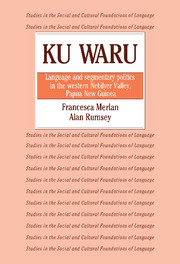Book contents
- Frontmatter
- Contents
- List of illustrations
- List of tables
- List of abbreviations
- Preface and acknowledgments
- 1 Introduction
- 2 The setting
- 3 Some aspects of Ku Waru segmentary sociality
- 4 Ceremonial exchange and marriage in the western Nebilyer Valley
- 5 Some linguistic structures of segmentary politics
- 6 Warfare compensation payment to Laulku: an analysis
- 7 Compensation at Palimung and the Kulka women's club
- 8 The events in perspective
- 9 Perspectives on ‘event’
- Appendix A Transcript of proceedings at Kailge on July 24, 1983
- Appendix B Grammatical sketch of Bo Ung, Ku Waru dialect
- Appendix C The conduct of warfare
- Appendix D Ku Waru metalinguistic expressions
- Chapter notes
- Glossary
- References
- Index
- Plate section
4 - Ceremonial exchange and marriage in the western Nebilyer Valley
Published online by Cambridge University Press: 30 December 2009
- Frontmatter
- Contents
- List of illustrations
- List of tables
- List of abbreviations
- Preface and acknowledgments
- 1 Introduction
- 2 The setting
- 3 Some aspects of Ku Waru segmentary sociality
- 4 Ceremonial exchange and marriage in the western Nebilyer Valley
- 5 Some linguistic structures of segmentary politics
- 6 Warfare compensation payment to Laulku: an analysis
- 7 Compensation at Palimung and the Kulka women's club
- 8 The events in perspective
- 9 Perspectives on ‘event’
- Appendix A Transcript of proceedings at Kailge on July 24, 1983
- Appendix B Grammatical sketch of Bo Ung, Ku Waru dialect
- Appendix C The conduct of warfare
- Appendix D Ku Waru metalinguistic expressions
- Chapter notes
- Glossary
- References
- Index
- Plate section
Summary
Having introduced the Ku Waru people and their ways of making segmentary social relationships, we turn now to some aspects of their social life which are partly consistent with that order of sociality and partly independent of it: ceremonial exchange and marriage. This will provide further necessary background for our analysis of events in Chapters 6 and 7, where we will explore some ways in which the significance of exchange transactions for these various dimensions of sociality is contested.
STRUCTURE AND HISTORY OF WESTERN NEBILYER CEREMONIAL EXCHANGE
New Guinea Highlanders are renowned for their elaborate systems of ceremonial exchange. The moka system of the Melpa people – eastern neighbors of the Nebilyer people – has been described in a monograph by Andrew Strathern (1971) and in many other publications by him and Marilyn Strathern. To the north-west, the tee system of the Enga has been described by Feil, Meggitt, and others (see section 1.2, references therein and below). In most respects, the ceremonial exchange practices of the Nebilyer, called makayl, resemble the Melpa moka more than the Enga tee. In the Nebilyer, all makayl (or moka) is claimed to have originated in claims for compensation arising out of warfare (cf. A. Strathern 1971:94ff. regarding the Melpa). Sometimes the parties between whom a makayl relation is established are ones who are said to have fought against each other. But in by far the majority of cases, they are parties who are said to have fought together as allies. Where the former is the case, the makayl transactions are talked about as a way of converting the relationship to an amiable one of wealth exchange.
- Type
- Chapter
- Information
- Ku WaruLanguage and Segmentary Politics in the Western Nebilyer Valley, Papua New Guinea, pp. 57 - 87Publisher: Cambridge University PressPrint publication year: 1991

